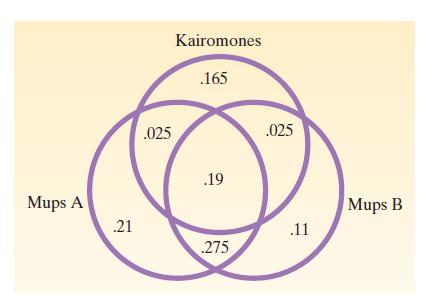Chemical signals of mice. The ability of a mouse to recognize the odor of a potential predator
Question:
Chemical signals of mice. The ability of a mouse to recognize the odor of a potential predator (e.g., a cat) is essential to the mouse’s survival. The chemical makeup of these odors—called kairomones—was the subject of a study published in Cell (May 14, 2010). Typically, the sources of these odors are major urinary proteins (Mups). Cells collected from lab mice were exposed to Mups from rodent species A, Mups from rodent species B, and kairomones
(from a cat). The accompanying Venn diagram shows the proportion of cells that chemically responded to each of the three odors. (Note: A cell may respond to more than a single odor.)
a. What is the probability that a lab mouse responds to all three source odors?
b. What is the probability that a lab mouse responds to the kairomone?
c. What is the probability that a lab mouse responds to Mups A and Mups B, but not the kairomone?
Step by Step Answer:

Statistics Plus New Mylab Statistics With Pearson Etext Access Card Package
ISBN: 978-0134090436
13th Edition
Authors: James Mcclave ,Terry Sincich





